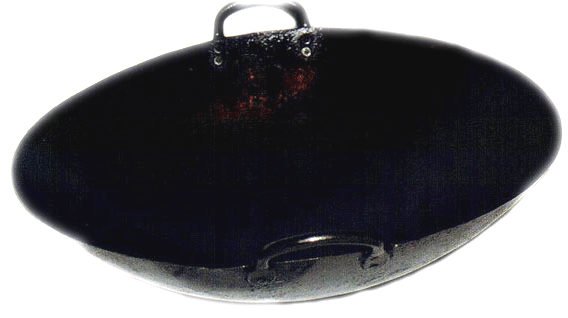 An iron pot with a round bottom requiring a metal ring to hold it steady
if placed on modern ranges.
An iron pot with a round bottom requiring a metal ring to hold it steady
if placed on modern ranges.
The wok is
one of the most practical utensils devised by man. It is an all-purpose
cooking
pan, with which many foods can be easily prepared-from
stir-frying to
braising, stewing,
deep frying (tsa),
steaming (jing), smother-cooking (munn),
red cooking (hung shu), casserole steaming (dun),
poaching (chung), toss
cooking (chao), boiling (bo), and light frying (jeen).
The wok heats over the wok's entire bottom
surface.
Some woks are made of aluminum or copper. The round bottom provides
flexibility in exposing portions to be cooked and allows the sauce and oil
drain to
the center where the heat is concentrated.
The wok's combined thinness and rounded bottom permit the quick cooking
and concentrated heat employed in most Chinese recipes. Stirring is
extremely
simple. Heat is radiated quickly and is evenly distributed, and the wok's
large
cooking area is convenient for toss-cooking (in which ingredients are
actually
tossed), or cooking odd-shaped foods (a whole fish with head) .
The wok's size depends upon the amount of food to be cooked (sizes range
for from one to ten servings). Diameters range from 10 to 24 inches (the
latter commonly used in restaurants). A 14-inch wok most often is recommended
for the American kitchen. Some 12-inch woks feature a
frying-pan-type handle. Attachments include a cover (usually
aluminum) and a deep cup for steaming or long cooking.
When purchased, the wok should be seasoned before it is used. Wash with hot water and
soap,
grease over the entire inside surface with peanut oil or any other kind
of
cooking oil, place over a high heat for about a
minute,
then rinsed with hot water, and the process repeated several times.
Seasoning
the wok with peanut oil seals the pores of the metal. This prevents the
ingredients from sticking and avoids a metallic flavor in the food. After
seasoning
it should be washed carefully with hot water only. Any excess oil on the
inside
should be scraped or scoured, without soap. Scouring here is defined as
rubbing with salt on a paper towel. Most often, residual gravy is scraped
with a
stiff brush and washed away in hot water. Gradually, as it becomes
seasoned,
the appearance of the wok changes from that of a shiny metal to black. It
is then ready for use, after which, because it is made of iron, it should be
dried
immediately over heat, after rinsing, to prevent rusting. A cast iron wok is
preferable to any other.



 .
.

 An iron pot with a round bottom requiring a metal ring to hold it steady
if placed on modern ranges.
An iron pot with a round bottom requiring a metal ring to hold it steady
if placed on modern ranges.